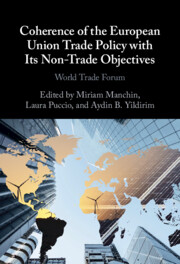Book contents
- Coherence of the European Union Trade Policy with Its Non-Trade Objectives
- Coherence of the European Union Trade Policy with Its Non-Trade Objectives
- Copyright page
- Contents
- Contributors
- Introduction
- 1 European Union Trade Policy and Non-Trade Issues
- 2 The European Union
- 3 Export Credit Agencies
- 4 The Effects of Non-Trade Provisions in Trade Agreements on Bilateral FDI
- 5 How EU Trade and Cooperation Policies Stimulated China to Go Green
- 6 The Role of Domestic Factors in the EU’s Governance of Labour Standards through Trade
- 7 EU Trade Agreements and Non-Trade Policy Objectives
- 8 Trade, the G20 and the EU
- 9 Enhancement of the European Parliament’s Monitoring for Better Coherence between Trade Policy and NTPOs
- Conclusion
- Index
- References
2 - The European Union
Soft and Smart Power in Aid and Trade?
Published online by Cambridge University Press: 19 October 2023
- Coherence of the European Union Trade Policy with Its Non-Trade Objectives
- Coherence of the European Union Trade Policy with Its Non-Trade Objectives
- Copyright page
- Contents
- Contributors
- Introduction
- 1 European Union Trade Policy and Non-Trade Issues
- 2 The European Union
- 3 Export Credit Agencies
- 4 The Effects of Non-Trade Provisions in Trade Agreements on Bilateral FDI
- 5 How EU Trade and Cooperation Policies Stimulated China to Go Green
- 6 The Role of Domestic Factors in the EU’s Governance of Labour Standards through Trade
- 7 EU Trade Agreements and Non-Trade Policy Objectives
- 8 Trade, the G20 and the EU
- 9 Enhancement of the European Parliament’s Monitoring for Better Coherence between Trade Policy and NTPOs
- Conclusion
- Index
- References
Summary
This chapter draws on Joseph Nye’s original definition of soft power as being the ability of a country or region to influence others by virtue simply of their wish to emulate them. As in the attractiveness of US culture during the cold war, and by the eagerness of post-communist Central and Eastern European countries to adopt the EU model as the basis of their economic and social reforms. The chapter notes however that while soft power is not a policy instrument as such, it can be linked to instruments such as aid or trade preferences to influence the behaviour of partners. The approach is therefore to look at the relationship between the values embodied in aid priorities of the EU institutions and the major donor states. Using a “Finger Kreinin Index” we find that the EU and its Member States are to some extent pulling in the same direction, but that the degree of coherence with the EU institutions varies across the key Member States. The tentative conclusion is that the EU and its Member States have been complementing rather than either replicating or contradicting each other’s actions.
- Type
- Chapter
- Information
- Coherence of the European Union Trade Policy with Its Non-Trade ObjectivesWorld Trade Forum, pp. 34 - 60Publisher: Cambridge University PressPrint publication year: 2023



